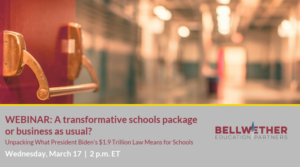 Yesterday, former Tennessee Governor Phil Bredesen, former DE and MD state chief Lillian Lowery, former RI and DC chief and current Tulsa PS Superintendent Deb Gist, and Ken Wagner, who led SEA’s in NY and RI to talk about lessons from the last big stimulus act (ARRA) in 2009. Video as soon as it’s processed and ready with close captions, for now a few takeaways:
Yesterday, former Tennessee Governor Phil Bredesen, former DE and MD state chief Lillian Lowery, former RI and DC chief and current Tulsa PS Superintendent Deb Gist, and Ken Wagner, who led SEA’s in NY and RI to talk about lessons from the last big stimulus act (ARRA) in 2009. Video as soon as it’s processed and ready with close captions, for now a few takeaways:
– There was a lively debate about maintenance of effort and state versus local roles. That seems like foreshadowing. Can states leverage their share of the education dollars – or other state dollars – to create incentives for collective approaches? Will local districts absorb it sponge-like or do some creative things? Governor Bredesen made the point that $100 can have more impact than 100 one dollars being spent. In a decentralized system like ours, efforts to make sure communities that need the dollars get them, so requirements to send them to LEAs, can also work at cross-purposes with efforts to coordinate. Very real tradeoffs.
– Getting both state and local points of view is key here and will be key to any successful planning efforts.
– This is not 2009 and circumstances are different. Fiscally, states are generally doing better than expected. That’s good news, but also a risk. Because the economy is coming out of the pandemic stronger than anticipated there is an opportunity to use this money in a forward-looking way. But structurally, politically, and culturally a lot in the education sector works against that. This is a big chance, once in a generation, to make real progress on issues like teacher diversity if we get it right.
– Lillian Lowery and Ken Wagner talked a lot about evidence and planning. Wagner warned pointedly that if this is rushed, it won’t go well. Given how the timelines work it’s fast deployment after states make their move and there will be pressure to rush. Planning is key, but hard to do even though the dollars overall have a long timeline in terms of their availability. What states will be bold and creative enough to take advantage of that? Bredesen, who used ARRA dollars to build consensus on issues that would not have been possible otherwise, suggested a big opportunity is using these dollars to build (or in the case of education perhaps rebuild) political consensus. There was general concern about taking on obligations that will be cost-prohibitive later, a sort of fiscal due no harm principle.
– Deb Gist pointed out the myriad needs in communities that LEAs are facing – especially given the K-shaped nature of the economic and pandemic impact over the past year. Those are real issues and a real pressure here as well.
– This is not the only money states and districts are figuring out how to use. Rather, it’s the third dollop. That, too, is an opportunity in terms of touching multiple bases at once, and also a challenge.
My big takeaway: this is an enormous sum of money. A stupid joke is now, ‘we’ve known each other since education spending was 20 percent lower than it is today.’ It’s hard to miss that outside of some creative and circumstantial local leadership the ARRA dollars didn’t have a lot of structural impact on school districts. Yes circumstances are different this time, and, yes, that could happen again. I’d suggest that if this money hits like a wave on a beach and then recedes leaving nothing but sea foam in its wake, it will set back efforts to address funding and fiscal equity for decades. It’s important to remember with all the revisionist history going on, ARRA was pretty popular when it first hit, too. There is a lot riding on this.
